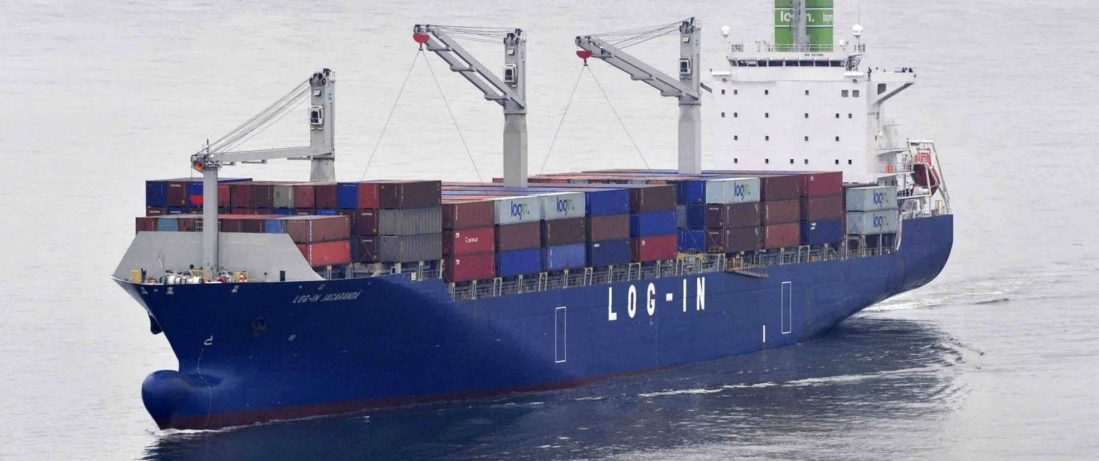
Log-In posta recorde de receita – cabotagem vencendo o caminhão
dez, 06, 2018 Postado pordatamarnewsSemana201848
Log-In Logistica Intermodal, o último permanecente armador de navios contêiner brasileiro, registrou um aumento de 266% na sua receita no terceiro trimestre deste ano comparado ao mesmo semestre do ano anterior, alcançando um recorde de R$60,7m apesar da fraca economia brasileira. Isto é atribuido ao aumento da cabotagem após a fatídica greve de onze dias dos caminhoneiros em maio e junho deste ano e o consequente aumento no frete dos caminhões atingido via o estabelecimento da tabela de frete mínimo. O volume de cabotagem no terceiro trimestre subiu 26% para 33.400 TEUs ma mesma comparação de períodos. A grande cabotagem (comércio entre Brazil e os outros páises do Mercosul cresceu 2,7% para 7.700 TEUs no mesmo período.
Log-In rides Brazilian cargo shift from truck to cabotage
In spite of a weak Brazilian economy, Log-In Logistica Intermodal SA, the last Brazilian-owned container shipping carrier, is capitalizing on shippers’ increased use of cabotage services because of higher trucking rates and a nationwide strike in May.
The Rio de Janeiro-based carrier’s earnings before interest, tax, depreciation, and amortization (EBITDA) in the third quarter rocketed 265.7 percent year over year to 60.7 million reais ($15.9 million), a company record. Net revenue for the feeder and Mercosur coastal trades operator rose 24.5 percent to 275.3 million reais within the same period. Log-In also runs the Terminal Vila Velha container facility at the port of Vitoria with the Santos port authority.
“The truck drivers’ strike in May and the current increase in freight cost have been incentives for the migration to the maritime mode,” said Marcio Arany, commercial director for Log-In Logistica. “Cabotage also offers better operational control and a reduction in the number of breakdowns and robberies.
Log-in provides detailed door-to-door risk management that mitigates cargo theft and has prevented any major thefts. Only 10 percent of containers, even for long distances, is moved by cabotage with trucking taking more than 80 percent and rail the rest. That’s changing largely because the creation of minimum trucking freight rates — part of the deal to end the labor action — has given shippers a reason to look at water-services beyond just truck disruption risks.
In the third quarter, cabotage volume rose 26 percent year over year to 33,400 TEU, while Mercosur coastal traffic inched up 2.7 percent to 7,700 TEU in the same period. Feeder traffic was down 4.7 percent to 42,400 TEU in the third quarter, but volume in the first nine months of the year is still up 7 percent compared to the same three-quarter period in 2017. Feeder cargo makes up about half of Log-In’s volume, having shifted from a 20 percent share in 2011 to more than than 60 percent in 2017.
Total coastal container volume including cabotage, in 2017 rose 11.9 percent from 2016 to nearly 1.1 million TEU, according to government statistics. Volume in 2017 was triple that of the 376,000 TEU shipped in 2009.
Log-In struggled in recent years after a 1 billion-reais order for seven ships couldn’t be completed by the builder after it went bankrupt, triggering a legal battle with carriers, eventually writing the costs off. In January 2016, it seemed that Manubi SA, a new shipping company, would buy shares in Log-In, which was up for sale, but the deal failed to materialize.
Log-In operates six container vessels — of between 1,700 TEU and 2,800 TEU, of which four are owned — along the Brazilian, Uruguayan, and Argentine coastlines, and Mercosur coastal shippong has grown roughly 10 percent annually over the last decade. The trade bloc, which also includes landlocked Paraguay, is on the verge of finalizing a free trade agreement with the European Union.
One of the main functions of cabotage in Brazil is the shipment of electronic goods and motorcycles from the Manaus Free Trade Zone to the rich southeast of Brazil (ports of Rio de Janeiro and Santos mostly), and foodstuffs, beverages, chemicals, and other goods in the other direction. Among the key shippers using Log-In are the food and beverage companies Sadia, Bunge, Ambev, and Camil, and the electronics companies Semp Toshiba, Sony, and LG Electronics. Other key shippers who use Log-In are Volkswagen, Pirelli, Monsanto, the steel companies Gerdau and CSN, Braskem, Johnson & Johnson, and the cellulose firm Suzano.
Mediterranean Shipping Co. (MSC), Hapag-Lloyd, Evergreen Line, and Ocean Network Express, (ONE) tap Log-In feeder services. Coastal carrier competitors Mercosul Line and Aliancaa are tied with CMA CGM and Maersk Line/Hamburg Sud, respectively.
Log-In was being positioned for a sale or injection of cash from a new partners roughly two years ago, but neither has materialized. Maersk Line and CMA CGM, which ended up buying Mercosul Line coastal carrier from Maersk Line and MSC, were seen as likely buyers or partners.
Post Relacionado
-
Grãos
jun, 07, 2023
0
Milho: line-up projeta embarques de 1,655 milhão de toneladas em junho na Argentina
-
set, 19, 2019
0
China aprova frigoríficos argentinos para exportação
-
Açúcar e Ethanol
maio, 04, 2023
0
Açúcar: Atrasos no carregamento e El Niño podem fazer preços subirem ainda mais, diz Dreyfus
-
Portos e Terminais
jul, 10, 2024
0
Navio de contêineres volta a atracar no Porto de Itajaí após 1 ano e meio e traz mais de 1900 veículos


